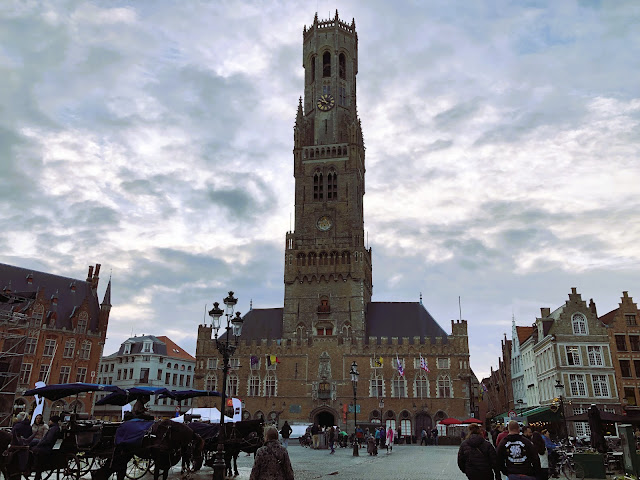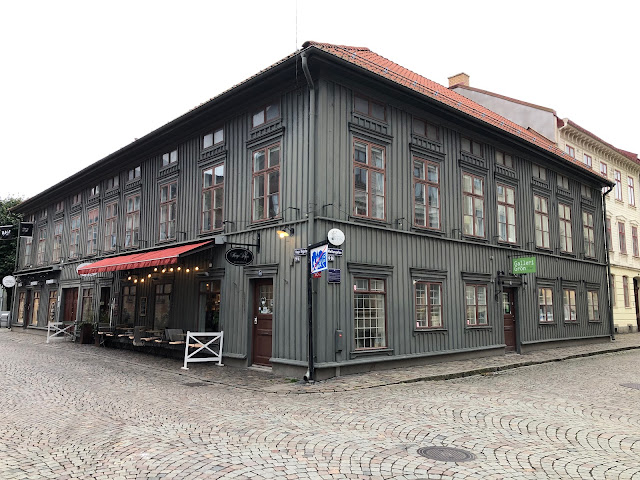EUROPE – PART 2
We’d been told that Oslo is a world-class city but, walking
along the dock in 1-degree C facing a stiff head wind just after sunrise, we
weren’t so sure. Google Maps directed us to the tourist information office
after a 40-minute walk through the very modern waterfront section, past the
cathedral and the parliament buildings, and into the old part of the city. Oslo
is the capital of Norway and is home to 700,000 people. Norway is one of the
richest countries in the world and its capital offers many demonstrations of the
country’s wealth.
The friendly agent gave us the maps we needed and
instructions to get to all the places we wanted to see using the metro and the
tram. We took her advice and bought two all-day tickets for $15.
We rode the metro to the end of the line at Frognersteren
which is 478 meters above the Central Station, making it the highest elevation
difference within a metro network in the world (today’s factoid). A skiff of
the year’s first snow covered the ground. Then we rode back down to
Holmenkollen, got off and walked up to the ski jump. The views around this area
and of the city below were incredible. And the thought of athletes skiing down
that ramp and flying through the air is mind blowing! The Holmenkollen ski jump
was used for the 1994 Winter Olympics, and the area next to the base of the
jump is the finish line for cross-country ski and biathlon. We chuckled as our
fellow Princess passengers got off buses, walked shivering through the
parking lot, went to the washrooms, snapped a few photos, and got back on.
We took the metro to the stop nearest to Frogner Park, had a
bite to eat, and walked to the park. It covers 45 hectares and is home to a
unique collection of 212 bronze and granite sculptures, all by the same artist,
Gustav Vigeland. The autumn leaves were spectacular and the sculptures very
interesting. I’m not sure what these two are doing but it sure looks like fun!
Next stop on the metro was the National Theatre and the Royal
Palace, home to Harald V, King of Norway since 1991, and Queen Sonja. Both were
born in 1937, so they’re no spring chickens! We walked up to the front of the Palace
and watched the Royal Guards pace back and forth before heading back to the
Theatre. From there, we took a couple of trams to get closer to where our ship
was docked. After more than 20,000 steps and 50 stories of climbing, we figured
we’d had enough for one day. What would have cost $840 had we taken Princess
excursions cost us $35. And we sure worked up an appetite for supper!
Our next stop, Rotterdam, is the second largest city in The
Netherlands, with a population of 700,000 or so, and is Europe’s busiest
seaport. Much of the city center was destroyed by German bombers during World
War II. The result today is an open and modern city featuring many different
architectural styles, some we liked and some we didn’t. The photo below shows
one of these strange structures, the Cube House, an apartment block near the
Market.
After getting some good advice from a friendly gentleman at
the tourist information center, we bought one-day public transit passes and
took the metro to the Central Station. From there, we boarded a bus to Delft,
home of the famous earthenware by the same name. Delft is to earthenware as
Waterford is to crystal. Again, we got our bearings from the local tourist
information center and walked from the bus station to the Delft factory,
following Google Maps on my iPhone. Along the way, we watched
scullers practice their stroke on the canal and were careful not to get run
over by the steady stream of bicycles.
We bought a few souvenirs at the Delft factory and Google
Maps directed us to the central square where City Hall stands opposite the
massive New Church. Unfortunately, we weren’t able to get good photos in the steady
rain and we’d have liked to just sit on a bench in the square just to take it
all in..
Back on the bus, we returned to Rotterdam Central Station and
took the metro to the Market Hall, a magnificent structure which dwarfs
everything around it. The walls and ceiling are too big to capture with our
antique iPhone 8s but we did our best. After having a bite there, we
took the metro back to the cruise terminal and rested our weary bones.
The Netherlands is an interesting country; very modern, very
clean, very organized, and the people seem quite well off. The Dutch began reclaiming
land from the sea in the 14th century and, today, 26% of the country
lies below sea level, protected by a complex system of dams, sluice gates,
storm surge barriers, drainage ditches, dikes, canals, and pumps. One source
states that as much as 90% of Rotterdam lies below sea level.
The photos below show the interior of the Rotterdam City
Market and the Erasmus Bridge taken on a very rainy day.
We’d been to Bruges once before in October 2017. We’d stayed
there two nights and explored the city on a very rainy day. This time, from the
cruise terminal in Zeebrugge, we left the ship before sunrise, rode the tram
and the train to Bruges and walked twenty minutes to the main town square, as
nice as we’ve seen anywhere in Europe. The whole center is a UNESCO World
Heritage Site and is certainly worthy of the designation. Horse-drawn carriages
clip-clop through the cobblestone streets and, on a Saturday morning, there’s
music everywhere! A bench in the main square is a great spot to people-watch
and listen to the carillon play a few classic tunes in the imposing Belfry. The
carillon is comprised of forty-seven bells, ranging in weight from two to
eleven thousand pounds and the sound is positively enchanting.
After relaxing in a café ($18 for a coffee and a tea!), we
took a thirty-minute canal cruise that gave us a different perspective of the
medieval town. We’ve been to this part of Europe twice now and feel most at
home in Belgium, The Netherlands, and Luxembourg. There is much to see, it’s
super easy to get around, it’s clean and safe, and the locals are very
friendly. Our only complaint is how expensive everything is, but that’s becoming
the way of the world, I guess… We headed back to the Island Princess
after a restful day, very satisfied with our visit.
I took it easy on the last day of our cruise. We took our
first Princess excursion to visit the Canadian D-Day landings in Normandy,
a two-hour bus ride away from our dock in the city of Le Havre. I’d wanted to
see Juno Beach, the place where Canadian troops landed on June 6, 1944, as part
of a 24,000-strong contingent of Allied soldiers and began the arduous task of
taking back Europe from the Nazis. Our excellent guide gave us a history lesson,
beginning with the 1919 Treaty of Versailles, the conditions of which generated
German anger and led eventually to the rise of Hitler and the Third Reich. There
followed the invasion of Poland in 1939, and the capture of the northern part
of France and its neighbours, Belgium, The Netherlands, Luxembourg, Denmark,
and Norway.
We began our tour at the Juno Beach Center in Courseulles-sur-Mer
before taking a walk to the beach at the very spot where the Canadians first
breached the German lines.
Then, we drove to the town of Arromanches-les-Bains where we
had lunch. Elva and I took a stroll through town to stretch our legs and ran
across this pretty cat on our way back to the bus. From Arromanches, we drove
to Gold Beach, site of one of the British landings, and learned about the
German artillery battery that pounded Allied landing craft. Seeing the size of
the cannons made us wonder how any of the landing craft made it ashore. By June
7, British troops had silenced them all, capturing the 180 survivors of the German
garrison.
The last stop on our Normandy Beaches tour was the Canadian War Cemetery in Bény-sur-Mer. The final resting place of more than 2,000 Allied soldiers, the majority of them Canadian, the site is located in the beautiful and peaceful French countryside, surrounded by farm fields. Like all of the Commonwealth War Graves site we’ve visited, as far away as Myanmar, it is immaculately kept; the gravestones line up flawlessly, the grass is trimmed to perfection, and the place projects an air of calm and peace. It wasn’t hard to spot the Acadian soldiers’ final resting places since each featured our flag at the base of its headstone. I shed a few tears as I paid my respects before the graves marked Arsenault, Gallant, Gaudet, and Cormier, none of them known to me but all of them distant cousins. Finally, it was time to return to the Island Princess for our last evening. We dined in style at the Italian specialty restaurant.
We really enjoyed our “COVID Cruise”. The places we’ll
remember most are the two world-class cities we visited, Copenhagen and Oslo,
and the equally charming smaller cities, Haarlem, Delft, and Bruges. The Normandy
Beaches visit was a highlight as well. I learned to navigate and use public
transit in most all the places we visited and really don’t understand why more
cruise passengers don’t do the same. Today, we’ll take the National Express bus
to Heathrow and fly to Zagreb, Croatia, to begin the second part of our
European adventure. Stay tuned!
































